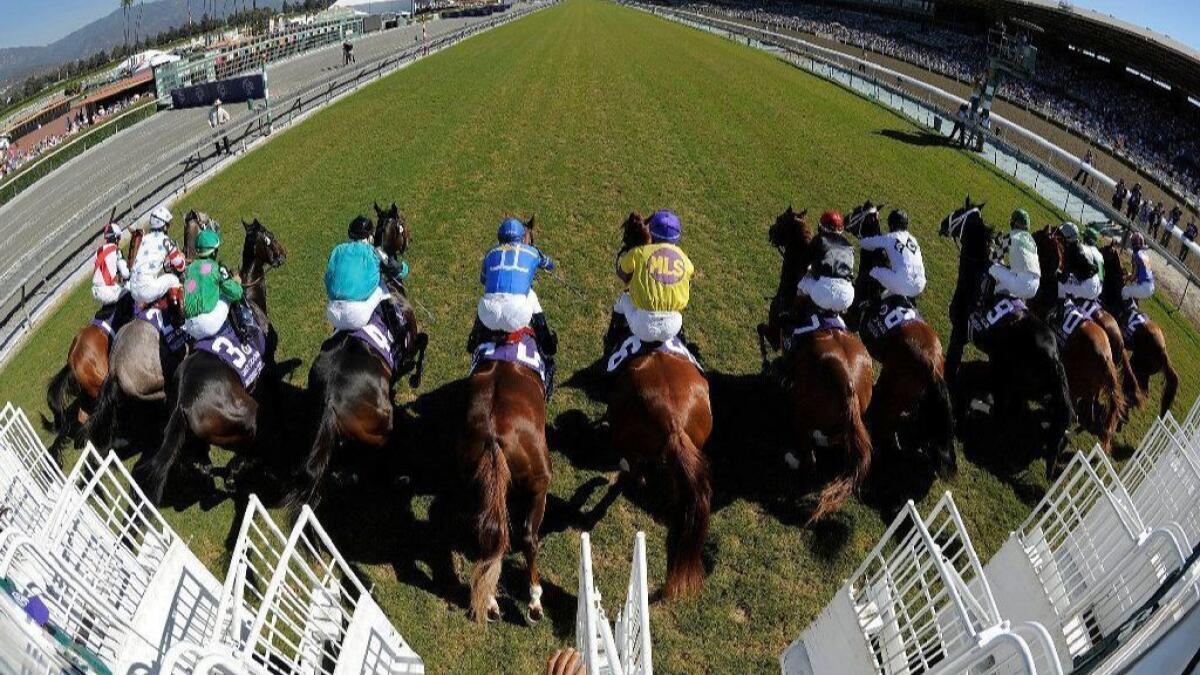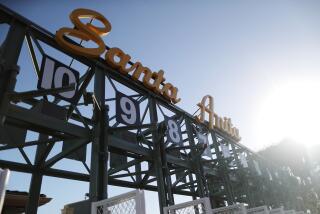Santa Anita cancels racing indefinitely after 21st horse dies at track since Dec. 26

- Share via
Only days before two of the biggest events on its schedule, Santa Anita on Tuesday suspended racing at least through this weekend — the announcement coming hours after the 21st horse fatality at the track since Dec. 26.
“In whole, we feel confident in the track and we’re just being very proactive,” said Tim Ritvo, chief operating officer of the Stronach Group, which owns and operates Santa Anita. “We want to do all the testing that needs to be done. When we believe we’re in good shape, we’ll start to train over it again.”
The move will force the postponement of the Santa Anita Handicap, a lucrative race for older horses, and the San Felipe Handicap, a major prep race for 3-year-olds trying to qualify for the Kentucky Derby. Both were scheduled for Saturday.
The fatalities became very public less than two weeks ago when two horses, including 2017 Breeders’ Cup winner Battle of Midway, died while training on a Saturday morning. Since then, two horses have died during training and one during racing.
The latest was Tuesday, when Lets Light the Way, a 4-year-old filly for owner-trainer Ron McAnally, was euthanized after injuring her right front leg.
It was the ninth death after an injury sustained during training on the main dirt track. Seven have died after racing on the dirt track and five on the turf track. The 21 fatalities are almost double all of last year, which was considered one of the safest in almost 25 years.
The question that everyone is trying to answer is why.
There are a litany of possible explanations.
The first thing experts look at is racing-surface irregularities; none were found during testing last week at Santa Anita.
Some abide by the theory that some horses, likely less valuable ones, are filled with legal drugs that mask symptoms of injuries so they can run. No evidence has been presented on this in regard to any of these fatalities. And there also is the issue that horses are not as durable as they used to be because they are being bred for speed, not long careers.
The track brought in Mick Peterson, a safety and racing-surface expert, to conduct tests on the track last week. But after analyzing all the data, including a radar examination of the track, he found nothing unusual and declared that the track was “100% ready” for racing.
Peterson is sending another one of his team of scientists back to the course for more testing. Santa Anita also hired Dennis Moore, a former track superintendent, as a consultant to evaluate the conditions.
“There are many different factors that can contribute to this,” Peterson said. “Surfaces and pre-race [veterinary] exams are two things that affect every horse, and then there is weather. We have to look at all of them and maybe we can figure a global risk factor.”
Santa Anita routinely sends sample soil tests to Peterson, who runs the University of Kentucky equine program, so there’s a baseline.
“I could find nothing different in the last two years,” Peterson said.
It is extremely difficult to save a horse that has suffered a serious bone break because it cannot be immobile for long periods of time without developing other problems. In many cases, such as 2006 Kentucky Derby winner Barbaro, laminitis develops in the hoof because of the uneven distribution of weight.
While Santa Anita is shut down, Los Alamitos Race Track in Cypress has offered its course for training.
The fatality problem has been apparent for several weeks, but no one was sure if it was a blip or something more.
“We first noticed it in mid-January,” said Rick Baedeker, executive director of the California Horse Racing Board. “We get daily reports from the safety stewards whenever there is a fatality. We were aware of the statistics and that led us to ask Dr. [Rick] Arthur, [the state’s chief equine veterinarian] to meet with people from the racing office.
“It was already a significant concern. But we’ve had situations in the past where there were extraordinary flurries and then nothing for a long time. You don’t know if it’s an anomaly. But here it went from bad to worse.”
Arthur did not participate in the decision to shut down racing, but he did agree with it.
“There certainly needs to be a stand-down and review of the situation that everything that needs to be fixed is fixed,” Arthur said. “I think the Stronach Group at Santa Anita made a good decision and is looking at the best interest of the horses. I know it’s a financial hit to them and horsemen, but they did the right thing.”
Sign up for our horse racing newsletter »
Although no conclusions have been made, there is a lot of finger pointing at the weather. Almost 12 inches of rain has fallen since the meeting began. Still, there is no quantifiable evidence that rain played a factor in the deaths.
“Maintaining a dirt track with the amount of rain we’ve had, you have to seal it at just the right time and right manner,” Arthur said. “You’re dealing with Mother Nature and it’s very hard to do perfectly. They realize things are not as good as they thought they were.”
Sealing a track is a process where the dirt is pressed down, not allowing the water to penetrate the surface but instead to roll off the dirt as if it were on a flat, hard surface.
The rash of deaths has brought protesters to Santa Anita, not an uncommon sight at racetracks even in good times.
PETA called on Gov. Gavin Newsom to close the track and asked the L.A. County district attorney to open an investigation into the use of drugs that mask injuries, forcing horses to run when they are not sound. The group did not offer any evidence in connection with any of these 21 deaths.
Fatality clusters are not new to racing. In 2016, Del Mar suffered a high number of fatalities on its turf course. The number was around 16, with some causes of death possibly not related to exercise-induced racing.
Joe Harper, the longtime chief executive officer and president at Del Mar, remembered it and the lessons learned.
“We put in a new turf course and you could only grow it so long in the desert,” Harper said. “So, it was harder than a normal turf course. We felt it was safe when we put it in, but then there were the breakdowns. What we found was it wasn’t the good horses that were breaking down.”
Del Mar canceled turf racing for several weeks until all the adjustments could be made to the course. Del Mar also cut down the number of horses at the track from about 2,300 to 1,900 to maintain a higher quality of stock.
Santa Anita has increased the number of races this meeting.
“You have to look at your entries,” Harper said. “And we found there were some horses that shouldn’t have been entered. … We’ve been talking to [Santa Anita] and offered them any help we can. I know how they feel. I’ve been there.”
In the winter of 2011-2012, 30 horses died at Aqueduct in New York, which led to the state taking a more active hand in regulating the sport. Many significant changes were made, which led to the reduction of equine deaths.
“But most of the changes that were made in New York have already been implemented in California,” Peterson said.
According to the CHRB, horse deaths have decreased by 60% over the last 13 years, with most of the reduction coming in the last couple of years.
As for the business of racing, there was no announcement of when the San Felipe and Santa Anita Handicap, known as the Big ’Cap, may be rescheduled. Races have to be spaced properly leading up to the Kentucky Derby, so delay of more than one week would seriously compromise a horse’s training and opportunity to run on the first Saturday in May.
The Santa Anita Handicap has more flexibility.
The reaction Tuesday among trainers was clearly on the side of safety.
“Without our athletes, without our most precious asset, there is no sport,” trainer Bob Hess Jr. said. “I guarantee all the trainers, owners, jockeys, grooms and hot walkers, we agree it’s best. Something is wrong and needs to be fixed and addressed immediately. It’s past the point of embarrassing.
“Santa Anita is the ‘Great Race Place’ and it’s not great. … Without the horses, we’re nothing. We live and die with these horses. It’s been a brutal last two or three weeks. I know they felt it was right when they stopped and brought in all these experts, but it wasn’t enough. Something is wrong and needs to be fixed.”
The Associated Press contributed to this report.
More to Read
Go beyond the scoreboard
Get the latest on L.A.'s teams in the daily Sports Report newsletter.
You may occasionally receive promotional content from the Los Angeles Times.












